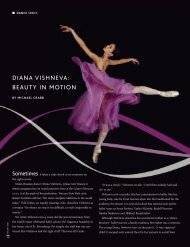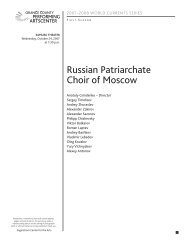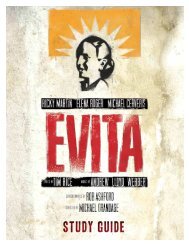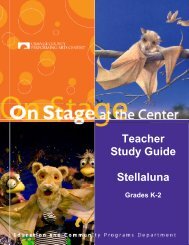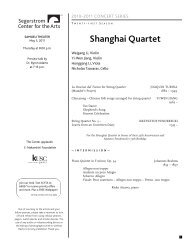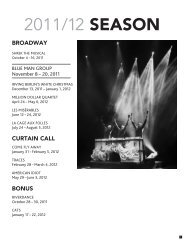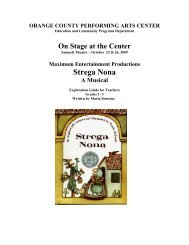SPRING AWAKENING - Segerstrom Center for the Arts
SPRING AWAKENING - Segerstrom Center for the Arts
SPRING AWAKENING - Segerstrom Center for the Arts
You also want an ePaper? Increase the reach of your titles
YUMPU automatically turns print PDFs into web optimized ePapers that Google loves.
teens comes up, “I cannot stand <strong>the</strong> creeping<br />
sensuality of <strong>the</strong>se liberal times.”<br />
The play also focused on o<strong>the</strong>r issues plaguing teens<br />
today: sex, abortion, coming into ones own and <strong>the</strong><br />
struggle that exists between teens and authority<br />
figures.<br />
Bertolt Brecht<br />
Epic <strong>the</strong>atre earned its name by using clear<br />
description, a reporting style, choruses and projections<br />
as a means of communicating with audiences. It<br />
renounced <strong>the</strong> romanticism of earlier <strong>the</strong>atre and<br />
presented characters who represented different sides<br />
of an argument. The audience was invited to draw its<br />
own conclusions about <strong>the</strong> situations presented in a<br />
more detached “scientific” way—an approach fully<br />
developed in <strong>the</strong> mid 20th century by noted German<br />
playwright, Bertolt Brecht. He called <strong>the</strong> scientific<br />
approach <strong>the</strong> “alienation effect.” Both Wedekind and<br />
Brecht used unrealistic sets and comedy to soften <strong>the</strong><br />
harsh realities of events presented in <strong>the</strong>ir plays.<br />
The ever-present anxiety of <strong>the</strong> characters in Spring<br />
Awakening <strong>for</strong>eshadowed <strong>the</strong> expressionist movement<br />
in German <strong>the</strong>atre which became prominent in <strong>the</strong><br />
early 20th century. Involving a distortion of emotion,<br />
<strong>the</strong> concept of expressionism was widely present in<br />
European art movements of <strong>the</strong> time. Edvard Munch’s<br />
“The Scream” is a good example of <strong>the</strong> expressionist<br />
style.<br />
The Scream by Edvard Munch<br />
Spring Awakening also incorporates an element of epic<br />
<strong>the</strong>atre called “breaking <strong>the</strong> fourth wall,--an imaginary<br />
partition at <strong>the</strong> front of <strong>the</strong> stage separating <strong>the</strong> actors<br />
from <strong>the</strong> audience. Theatrically speaking, “<strong>the</strong> <strong>for</strong>th<br />
wall” is meant to symbolize <strong>the</strong> barrier between <strong>the</strong><br />
world of fiction on stage and <strong>the</strong> audience. When an<br />
actor “breaks <strong>the</strong> fourth wall” he or she speaks to <strong>the</strong><br />
audience directly. These techniques are regularly used<br />
in today’s sitcoms filmed be<strong>for</strong>e live audiences. In <strong>the</strong><br />
show “Malcolm in <strong>the</strong> Middle”, <strong>the</strong> main character<br />
often speaks directly into <strong>the</strong> camera while o<strong>the</strong>r<br />
characters seem not to hear him. One actor can also<br />
play several rolls, as <strong>the</strong> two “adults” in <strong>the</strong> musical<br />
version play mo<strong>the</strong>rs, fa<strong>the</strong>rs, headmaster and mistress<br />
of <strong>the</strong> school. All of <strong>the</strong>se techniques are present in<br />
1800s German <strong>the</strong>atre, which one can safely assume<br />
was light years ahead of its time.<br />
17



